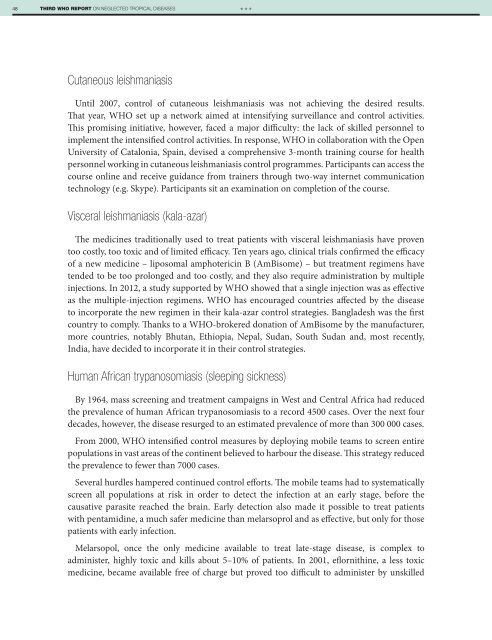1A9bnbK
1A9bnbK
1A9bnbK
Create successful ePaper yourself
Turn your PDF publications into a flip-book with our unique Google optimized e-Paper software.
48 THIRD WHO REPORT ON NEGLECTED TROPICAL DISEASES<br />
***<br />
Cutaneous leishmaniasis<br />
Until 2007, control of cutaneous leishmaniasis was not achieving the desired results.<br />
That year, WHO set up a network aimed at intensifying surveillance and control activities.<br />
This promising initiative, however, faced a major difficulty: the lack of skilled personnel to<br />
implement the intensified control activities. In response, WHO in collaboration with the Open<br />
University of Catalonia, Spain, devised a comprehensive 3-month training course for health<br />
personnel working in cutaneous leishmaniasis control programmes. Participants can access the<br />
course online and receive guidance from trainers through two-way internet communication<br />
technology (e.g. Skype). Participants sit an examination on completion of the course.<br />
Visceral leishmaniasis (kala-azar)<br />
The medicines traditionally used to treat patients with visceral leishmaniasis have proven<br />
too costly, too toxic and of limited efficacy. Ten years ago, clinical trials confirmed the efficacy<br />
of a new medicine – liposomal amphotericin B (AmBisome) – but treatment regimens have<br />
tended to be too prolonged and too costly, and they also require administration by multiple<br />
injections. In 2012, a study supported by WHO showed that a single injection was as effective<br />
as the multiple-injection regimens. WHO has encouraged countries affected by the disease<br />
to incorporate the new regimen in their kala-azar control strategies. Bangladesh was the first<br />
country to comply. Thanks to a WHO-brokered donation of AmBisome by the manufacturer,<br />
more countries, notably Bhutan, Ethiopia, Nepal, Sudan, South Sudan and, most recently,<br />
India, have decided to incorporate it in their control strategies.<br />
Human African trypanosomiasis (sleeping sickness)<br />
By 1964, mass screening and treatment campaigns in West and Central Africa had reduced<br />
the prevalence of human African trypanosomiasis to a record 4500 cases. Over the next four<br />
decades, however, the disease resurged to an estimated prevalence of more than 300 000 cases.<br />
From 2000, WHO intensified control measures by deploying mobile teams to screen entire<br />
populations in vast areas of the continent believed to harbour the disease. This strategy reduced<br />
the prevalence to fewer than 7000 cases.<br />
Several hurdles hampered continued control efforts. The mobile teams had to systematically<br />
screen all populations at risk in order to detect the infection at an early stage, before the<br />
causative parasite reached the brain. Early detection also made it possible to treat patients<br />
with pentamidine, a much safer medicine than melarsoprol and as effective, but only for those<br />
patients with early infection.<br />
Melarsopol, once the only medicine available to treat late-stage disease, is complex to<br />
administer, highly toxic and kills about 5–10% of patients. In 2001, eflornithine, a less toxic<br />
medicine, became available free of charge but proved too difficult to administer by unskilled


